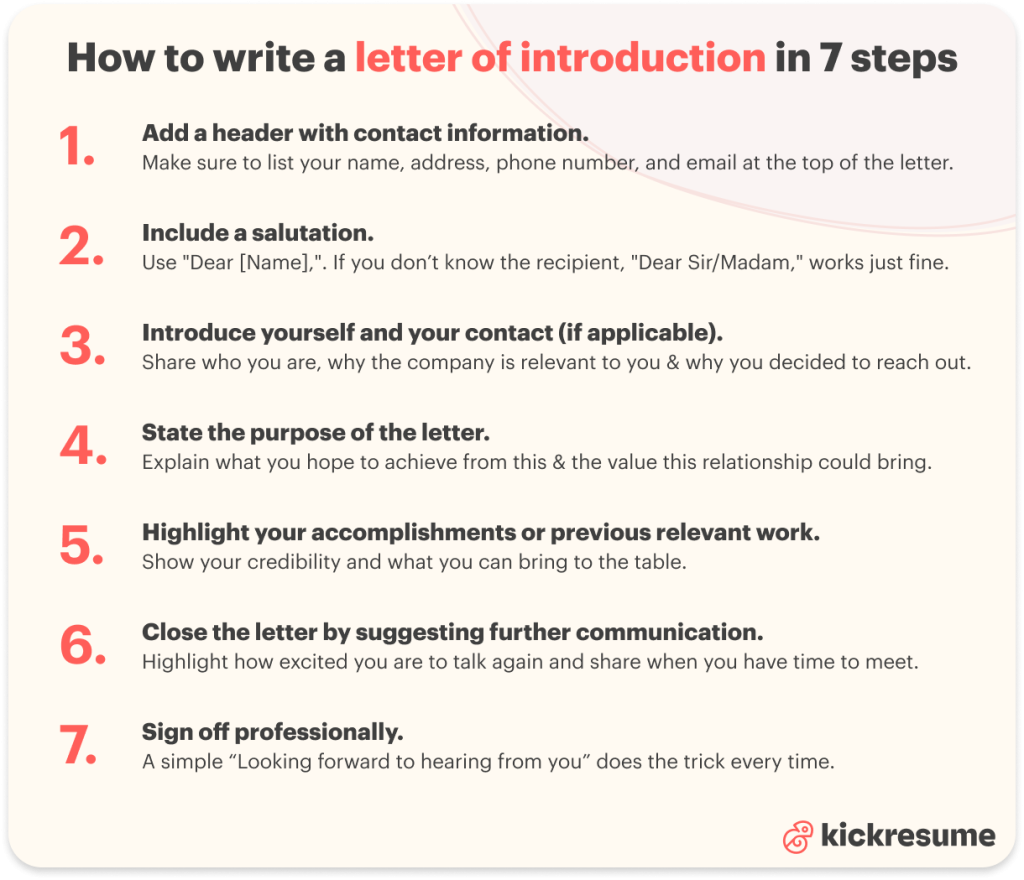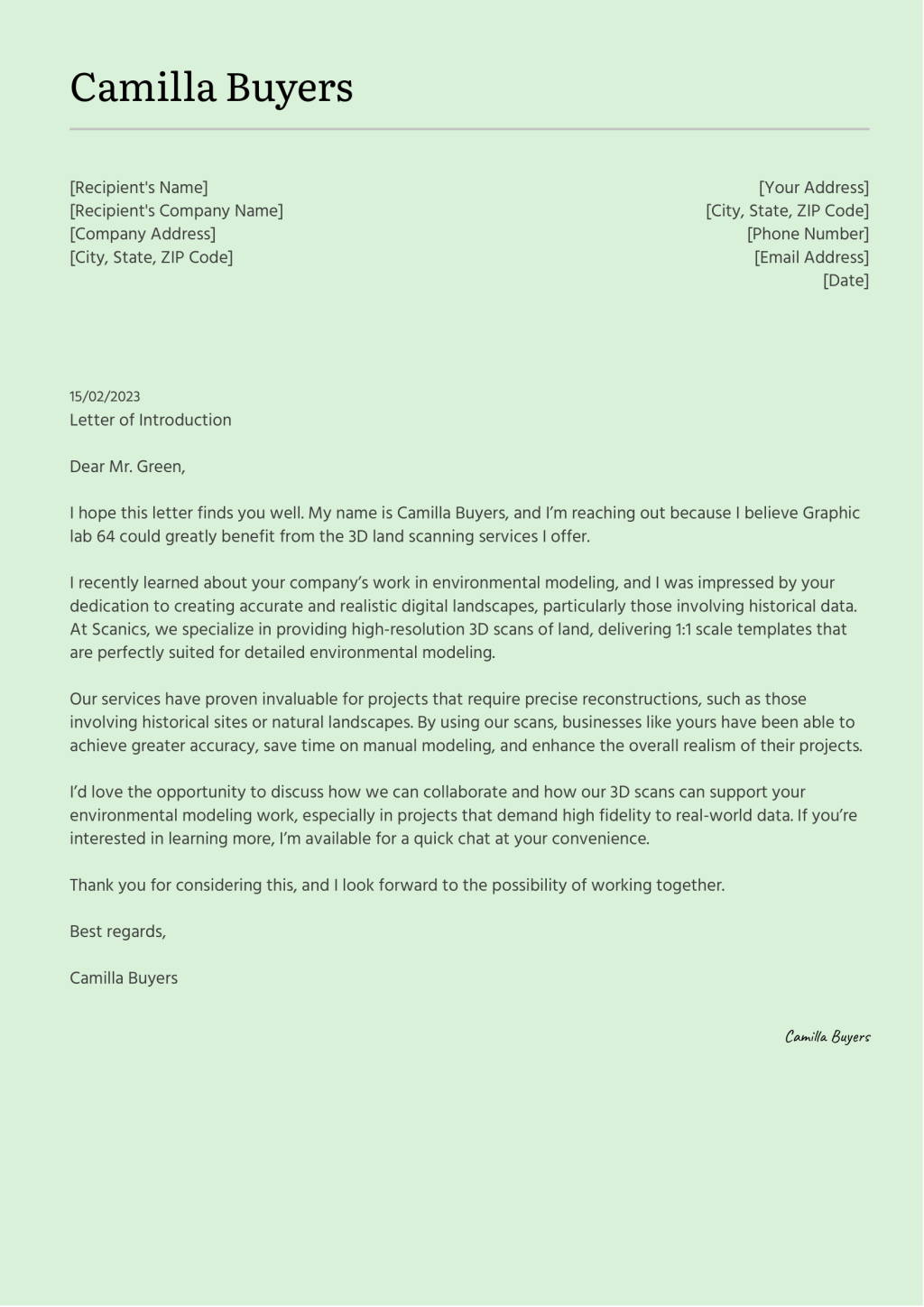Ever heard of a letter of introduction? If not, you’re not alone. While most people are familiar with resumes, cover letters, and even motivation letters, the letter of introduction remains a bit of a hidden gem in the professional world.
And that’s exactly why it could be your secret weapon.
Because it’s less common, sending one can really make you stand out and leave a lasting impression.
Writing a letter of introduction isn’t quite like drafting other career documents, but don’t worry—we’ll walk you through it step-by-step and share some examples you can use for yourself.
What is a letter of introduction?
A letter of introduction is a brief letter used to introduce yourself or someone else to a third party, whether that’s a potential employer, business contact, or client.
It's a simple yet powerful tool that often flies under the radar in the professional world.
Unlike a cover letter or resume, a letter of introduction isn’t tied to a specific job application.
Instead, it’s more about opening doors and starting conversations. Think of it as a way to make connections that can lead to new opportunities, without the formalities that come with other career documents.
Letter of introduction vs. cover letter vs. motivation letter
You might feel it sounds a bit similar to a cover letter or even a motivation letter.
While there are many similarities between these documents, the key difference lies in their purpose, main focus, and the target audience.
While a cover letter serves as an extension of your resume and is tailored to a specific job posting, a motivation letter is typically used in academic settings, such as when applying for educational programs or scholarships.
In contrast, a letter of introduction is primarily used for connecting and networking, without the immediate goal of securing a specific job or degree.
Let's take a closer look at what these documents are, when you should write them, and to whom:
Cover letter
- Purpose: Accompanies your resume to express interest in a specific job.
- Main focus: Adds more details to what’s already in your resume. Use it to explain why you’re the right fit for the job, highlight your skills, and achievements.
- Target audience: Employers, HR managers.
And if you want to learn more about writing a good cover letter, here's the only cover letter guide you'll ever need.
Letter of introduction
- Purpose: Introduces yourself or someone else to a company, potential client, or business partner without a specific job in mind.
- Main focus: Introduces your skills and experience to build a connection and make a positive first impression. If written for someone else, it highlights their qualifications and explains why they’re worth connecting with. This letter is flexible, useful for exploring job opportunities or business partnerships.
- Target audience: Potential employer, client, business partner, or collaborator.
Motivation letter
- Purpose: Explains why you're applying for a specific job, scholarship, or university program.
- Main focus: Focuses on your passions, goals, and reasons why you're interested in this job or educational programme. Highlights why this opportunity would enrich your work life and enhance your skills.
- Target audience: Academic institutions, NGOs, or employers.
When should you write a letter of introduction?
A letter of introduction serves a different purpose compared to other career documents like a cover letter or a resume.
Whether you’re looking to introduce yourself to a company, recommend someone else, or explore new professional relationships, there are several situations where a letter of introduction is the ideal tool.
Here are some key scenarios when you might consider writing one:
- You want to reach new clients and customers. Writing a letter of introduction for customers or new clients helps build a personal connection. It also explains how your products or services can meet their needs.
- You're looking for a new job. It helps you introduce yourself to a potential employer, show your interest and enthusiasm for the company, and highlight how your skills could be a good fit. Even if there's no job opening posted.
- You just started a new job. When you start a new job, a letter of introduction helps your coworkers or teammates get to know you. Your manager might also send a letter to introduce you to the team.
- You're looking for a business partner/collaborator. An introduction letter is often used as the first point of contact with a potential business partner or collaborator who shares your interests or industry. Its goal is to expand your network, which could lead to mutually beneficial opportunities, such as joint ventures, partnerships, or new projects.
- Someone you know recommended you. If someone you know recommends you to others, an introduction letter can be a great way to follow up and explore collaboration or job opportunities.
- Someone asked you to recommend them. You would introduce the person to your team or employer trying to highlight their skills and qualifications. The goal is to create a connection between your company or team and the person you’re introducing.

How to write a letter of introduction (7 simple steps)
Depending on the scenario, a letter of introduction can vary in tone and content, but the core structure remains the same.
These 7 simple steps will guide you in writing a clear and effective letter, no matter the situation:
- Add a header with contact information.
Start with a header that includes your contact details—it's an obvious but important step. Make sure to list your name, address, phone number, and email at the top of the letter. You can also add the date and the recipient's information, like their name, company, and address.
- Include a salutation.
Always address the recipient. If you're addressing someone you already know or who knows of you, start with a warm, friendly greeting. Typically, you’d use "Dear [Name],". If you don’t know the recipient, "Dear Sir/Madam," works just fine.
- Introduce yourself and your contact (if applicable).
Start with introducing yourself and explaining why you're writing. Share who you are, why the company is relevant to you, and why you decided to reach out. Mention how you found out about the company or who referred you, and briefly introduce the person who connected you.
- State the purpose of the letter.
This is where you get straight to the point. Explain why the company or work is important to you and what you hope to achieve from this connection. Highlight the benefits and the potential value this relationship could bring.
- Highlight your accomplishments or previous relevant work.
Mention your previous work to show your credibility and what you can bring to the table. You should also briefly highlight your accomplishments. Understanding your background can help you stand out and be seen as a valuable candidate for the job.
- Close the letter by suggesting further communication.
End your letter with a polite conclusion, suggesting further communication. Highlight how excited you are to talk again and share when you have time to meet.
- Sign off professionally.
Now, all you have to do is sign off. Professionally, of course. A simple “Looking forward to hearing from you” does the trick every time.
Letter of introduction example
We’ve covered the 7 key steps to writing a letter of introduction in theory.
Now, let’s take a look at an example that brings all these steps together.
BTW, this example was created using Kickresume’s cover letter builder tool. Even though it’s meant for writing cover letters, you can use it to write your letter of introduction, instead. The tool won't mind :)

Letter of introduction template
We also prepared a few letter of introduction templates you can copy & paste and personalize.
Just pick one that suits your situation the best.
#1 For when you want to reach new clients and customers
#1 Letter of introduction template
#2 Letter of introduction template
#3 Letter of introduction template
#4 Letter of introduction template
Key takeaways: Letter of introduction
A letter of introduction is a valuable tool for making new connections, reaching out to potential employers, or helping you during your job hunt.
There are a couple of different situations when writing a letter of introduction is appropriate.
For example when:
- You want to reach new clients and customers
- You just started a new job
- Someone you know recommended you to someone
- Someone asked you to write one for them
- You're looking for a new job
- You're looking for a business partner/collaborator
The details may vary slightly depending on the context, but following these 7 steps will help you prepare a strong letter of introduction in any scenario:
- Add a header with contact information
- Include a salutation
- Introduce yourself and your contact (if applicable)
- State the purpose of the letter
- Highlight your accomplishments or previous relevant work
- Close the letter by suggesting further communication
- Sign off professionally
If you’re still in doubt about writing your letter of introduction, don’t hesitate to use the templates provided in the article.



